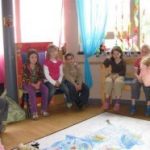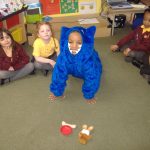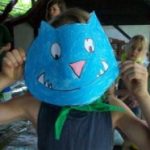
Clearly research shows that bites to young children in the home are an issue. What better way to reach a wide audience of children between the ages of 3 and 7 than introducing the Blue Dog programme into the school curriculum. In this way it is possible to reach an audience wider than those who have a family pet of their own.
All children will have the opportunity to learn how to interact
with dogs they may meet in their own home or in the homes of friends.
Safeguarding children is of the utmost importance and one
of the key responsibilities of the primary school. The Blue Dog programme not only fulfils the criteria of promoting a safe environment but allows children themselves the opportunity to educate parents and family.
(The picture shows children during a lesson at Scargill school)
Blue Dog affords many opportunities to address a variety of areas within The Early Years Foundation Stage (EYFS) Development Matters Curriculum (-> 5 years).
A few examples include:
- Self Confidence and Self Esteem: Begin to recognise danger and know who to turn to for help; Showing increasing confidence in new situations; Have a developing awareness of their own needs, views and feelings, and be sensitive to the needs views and feelings of others.
- Making relationships: Demonstrate flexibility and adapt their behaviour to different events, social situations and changes in routine.
- Behaviour and Self Control: Show care and concern for others, for living things and the environment.
- Language for Communication: Question why things happen and give explanations.
- Language for Thinking: Begin to use talk to pretend imaginary situations; Use language to imagine and recreate roles and experiences.
- ICT: Use a mouse and keyboard to interact with age appropriate computer software.
- Health and Body Awareness: Show awareness of their own needs with regard to eating, sleeping and hygiene.
- Creative Development: Exploring media and materials; developing imagination and imaginative play.
A similar range of cross curricular opportunities is available in the Key Stage 1 Curriculum (6-7 years).This would include PSHE (Personal, Social and Health Education), Citizenship, Literacy including Speaking and Listening and Writing, ICT, Thinking Skills and Art and Design and Media.
Find out more headline facts and figures or delve deeper into the research abstract data. Your queries may be answered in the Frequently Asked Questions section. If not, why not e-mail us your question directly for feedback?
Once you are convinced about the relevance of the Blue Dog for the children in your school, check out ideas about how to introduce the programme as well as more detailed lesson plan ideas.
The Download section of the website provides a wealth of useful material.
These ideas were originally developed by Moira Butcher, Jan Barnett and Judy Munford, teachers from the Hacton and Scargill schools within the London Borough of Havering, UK.
However, feedback from teachers within Belgium and the Netherlands indicate that the concepts and ideas can easily be adapted to the teaching regimes in their countries (the picture shows a lesson in progress in a school in Kortijk, Belgium). As a result of this, the Government of Vlaams Brabant have given financial support to the Teachers Toolbox section of the website.
Experience of trying to introduce the pilot programme in a number of schools has indicated that you are more likely to be successful if most of the staff (especially those in management roles) understand and “buy-in” to the project.
The Blue Dog research also highlights that parental involvement is important. This is true for all accident prevention initiatives, so it is important to get parents involved at an early stage.
A suggestion of how best to introduce the programme is:
Initially assess the programme and resources as a whole and identify opportunities to introduce them into your existing schedule – that is to enhance the work you already do, or develop new ideas.
- Introduce the Blue Dog programme to school staff at a staff meeting. A power point presentation with added notes is available as a download. This sets out an overview and hopefully will stimulate interest. Stress that a wealth of facts and figures are available on this website.
- Involve the parents and governors with a similar presentation thereby involving the wider community and promoting community cohesion.
- Develop and introduce the Scheme of Work for 4 – 7 year olds.
- Invite your local veterinarian and/or veterinary nurses to visit the school. Their involvement in role play and speaking and listening activities may be invaluable. They should already be familiar with the programme as this has been discussed widely within the veterinary profession for some years.
Your veterinarian may not be used to talking to young children, but would want to do a good job. You are the one who knows your children best – so do not be afraid to make suggestions. These will probably be much appreciated! - Organise a visit to a local Veterinary Clinic or Hospital. This may well be possible but will depend on the size of the clinic or the number of children etc. Perhaps it could tie in with a practice open day or other initiative. The important thing is to build up a relationship – then it is surprising what is possible!
- Develop further cross curricular links. The lesson plan section gives examples such as interactive story books, puppets, and animated films.
There are lots of opportunities – and they are fun!
But think up your own ideas and perhaps give us feedback via the contact us section.
Why not add a photo? As long as there is appropriate permission, we could add your ideas to the news section and Teachers Toolbox.
Browse Lesson Plans by Package
Reception Year – Ages 4 – 5 (Click to view lessons)
- Reception Year – Initial session
- Reception Year – lesson 1
- Reception Year – lesson 2
- Reception Year – lesson 3
- Reception Year – lesson 4
- Reception Year – Session ideas
Year 1 – Ages 5 – 6 (Click to view lessons)
- Year 1 – lesson 1
- Year 1 – lesson 2
- Year 1 – lesson 3
- Year 1 – lesson 4
- Year 1 – lesson 5
- Year 1 – lesson 6
Year 2 – Ages 6 – 7 (Click to view lessons)
- Year 2 – lesson 1
- Year 2 – lesson 2
- Year 2 – lesson 3
- Year 2 – lesson 4
- Year 2 – lesson 5
- Year 2 – lesson 6
By following the links you can go to the specific type of downloads:
Cards – Cartoon Dog Types
Cards – Childrens Clothes
Cards – Food For Dogs
Cards Food For Children (That dogs might steal)
Cards – Objects For Blue Or Children?
Cards – Places For Children And Dogs
Cards – Toys For Children Or Dogs
Cards – Where do these Animals Live?
Cards – Which Animals Are Pets?
Colouring Plates – Blues World
Craft Package – Make An Animal
Drawing Package – Join The Dots
Pictures – Blues Photo Album











